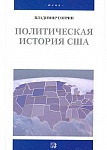Политическая история США
Those who want to know what Russian specialists in U.S. history were saying about their subject ten years after Russia ceased to be a Marxist-Leninist state (at least in name) will find Vladimir V. Sogrin’s book very interesting. The book, published in a fairly large press run, has helped the average informed Russian citizen reformulate his understanding of what the United States was like at various stages in its existence.
Sogrin divides U.S. political history into five stages, based upon what elements dominated the country’s political elite. These stages are the colonial era up to 1770, 1770 to 1820, 1820 to 1870, 1870 to 1930, and 1930 to 2000. He sees the colonial era as an amalgamation of English political traditions and American innovations. In this period, he says, monarchical and aristocratic elements gradually lost strength as representative elements grew stronger, with the major role held by an oligarchic elite that was appointed rather than elected.
The period from 1770 to 1820 witnessed the strengthening and growth of such democratic principles as the rule of law, democratic constitutionalism, the separation and limitation of powers, and the two-party system. The nature of the political elite changed; it was now elected, either directly or indirectly, but it possessed many undemocratic traits. It was recruited from narrowly defined upper strata of society, to which middle- and lower-class elements could only aspire. In practice, the country’s upper strata, drawn from the propertied elite, controlled its politics.
From 1820 to 1870, the interrelationship of elitism and democracy changed. This period witnessed a second major transformation of American society. The electorate was significantly broadened; it became more politically active and independent. The elite became more open, more responsive to the electorate, and more subordinate to the wishes of its constituents. Sogrin considers this the period of democratic elitism.
The fourth period runs from the end of the Civil War to the onset of the New Deal, and it was dominated by a capitalist elite made up of industrialists and financiers who established economic domination of the country following the Civil War. This system was checked by important democratic phenomena at the beginning of the twentieth century, but the upper classes regained a commanding position in the aftermath of World War I.
In the 1930s, with the country mired in the Great Depression, the United States returned to the model of democratic elitism, which it has preserved to the present day. Approximately the final 40 percent of the book deals with political developments in the United States from the 1930s through the 1990s.
In one sense, what Sogrin is offering is an approach to U.S. political history based on economic determinism but without tendentious quotations from V. I. Lenin and others. In another sense, however, he is offering his Russian readers an interpretation of American history they can understand, on the basis of their earlier education, but without the condemnation of the American political system that used to be required in Soviet days.
In a society long dominated by an elite professing a strongly held sociopolitical ideology, historical works intended for popular consumption sell best when they reinforce popularly held viewpoints without supporting obsolete historical interpretations. Vladimir Sogrin is to be congratulated on having produced a work that proves itself satisfactory on that level.
|
Согрин В.В.
2001 г.
|

